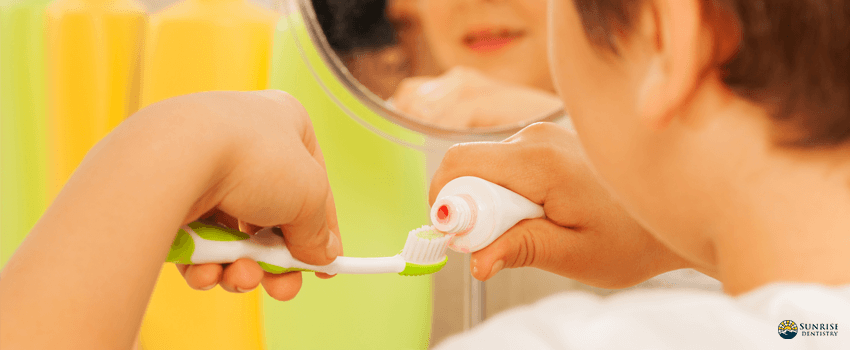Tooth decay is the most common chronic condition in children worldwide.
It can cause pain, infection, sleeplessness, eating problems, and school absences. In the United States alone, more than half of kids aged six to eight had or have a cavity in one of their baby teeth, and teens aged 12 to 19 had or have cavities in one of their permanent teeth.
Toothpaste manufacturers have long promoted toothpaste brands aimed at children to help combat this problem. Some are covered with popular cartoon characters, and many come in various flavors like strawberry, bubblegum, and fruit burst. They are also more expensive than normal adult toothpaste, but most parents will still buy them to provide the best oral care for their children.
Adult vs. Children’s Toothpaste: What’s the Difference?
As adults, we know how important it is to maintain healthy gums and teeth and that the best way to protect them is by brushing them at least twice daily. We should also know that choosing the right toothpaste for your needs is important; most kinds of toothpaste have the same ingredients, but it’s still important to look at each one, especially children’s toothpaste. How different are children’s toothpaste from regular ones? Let’s find out.
Fluoride Content
An adult’s teeth are different from a child’s; they will also have different needs. Your child’s toothpaste might have different ingredients or a fewer amount of substances than yours.
A child’s toothpaste has a lower fluoride content to prevent them from getting too much. Young children often don’t spit out the toothpaste after brushing; sometimes, they ingest it. This may lead to fluorosis, a condition where white spots develop on your child’s teeth or kidney damage due to excessive fluoride. Children’s fluoride-free toothpaste is also available for extra safety.
Flavors
Getting a child to brush their teeth can get difficult, especially if a regular toothpaste’s flavor puts them off.
Most traditional kinds of toothpaste leave a minty, clean feeling. However, many children find this flavor too spicy or burning, which may deter them from brushing their teeth.
Bubblegum toothpaste is one of the most popular children’s toothpaste flavors. Many kids enjoy this flavor, and many manufacturers have them. Some children might prefer fruity flavors like strawberry, mango, or watermelon, and some might like sweet flavors like chocolate or vanilla. As long as your child likes the flavor and gets excited to brush their teeth because they like the toothpaste, you’ve already won half the battle of getting them to brush their teeth.
Children’s Toothpaste: Do’s and Don’t’s
Want to know when to stop using children’s toothpaste? Most experts agree that the right time is around six or seven years old; most kids know not to swallow the toothpaste and have the correct hand control for brushing teeth.
Here are other things to know about using children’s toothpaste:
Use The Right Portion
According to the American Dental Association’s new guidelines, parents should use a smear of toothpaste no larger than a grain of rice to brush the teeth of children under three. Parents should also brush their teeth at least twice daily, in the morning and at night. When they turn three, they should continue to brush twice a day, but this time with more toothpaste the size of a pea.
Spit, but Don’t Rinse
Teach your child to spit out the toothpaste after brushing their teeth, but don’t let them rinse their mouth with water. This helps keep the fluoride in your mouth, strengthening their teeth overnight.
Always Supervise
Supervising your child’s brushing sessions helps them become more confident in knowing they’re doing it right. Brush your child’s teeth until they are six or seven years old; they won’t have the necessary hand-eye coordination and grip before then.
Seal of Acceptance
Whether you’re just starting to teach your child about brushing their teeth, it’s important to use products with the ADA Seal of Acceptance. It signifies that your child’s toothpaste has been subjected to rigorous quality control and has been objectively reviewed and tested for safety and efficacy.
What is the best children’s toothpaste? Your dentist is the best person to answer this question; they are the most knowledgeable about what product is most suited for your child.
Tips To Make Brushing Teeth Fun
Aside from using your child’s favorite toothpaste, make brushing teeth more fun with these tips.
Make it part of their routine.
Routines help a child thrive, feel safe, and build good habits. It’s best to teach your child that teeth brushing is a regular part of their day. They should know that brushing is always part of their mornings after breakfast and nights before bed. You should also explain to them why good dental habits keep them healthy.
Play pretend.
Playing pretend with your toddler is a fun and excellent way to help them learn about brushing. After brushing their teeth, play with them using their dolls, and tell them that it’s now their turn to “brush” their doll’s teeth to keep their smile nice and healthy.
Add some music.
You can add a relaxing and fun sensory element to your teeth-brushing experience by playing music. It can also help remind your child how long it should take for them to brush their teeth; some kids tend to brush for 10 seconds instead of the recommended two minutes. You can also find some musical toothbrushes with buttons your child can press to play music. They begin brushing when the music starts, then stop when the music ends.
You can use music to remind your child how long it takes to brush their teeth. This is particularly useful if your child brushes their teeth only for 10 seconds instead of the recommended 2 minutes.
You can also sing a song to keep your child entertained while brushing their teeth.
Let them take over.
Let your child brush the teeth first when they are at an age where it is easier to do all of it themselves. Watch them closely to see if they’re doing it properly or missed a spot. Give them control by letting them start and mimic what they’re doing to make it more fun and comfortable.
You could also let them “help” you brush your teeth. Show them how to brush while they brush their teeth, then take turns brushing each other’s teeth.
Make Oral Health More Fun With Sunrise Dentistry
Establishing early oral health care routines is the best way to take care of your child’s teeth that will last until adulthood. Our friendly dentists in Durango, CO, are happy to be part of your child’s journey to oral health wellness. They also perform mercury-free and holistic dentistry that is safe for you and your child. Contact us today for more information about our services.





